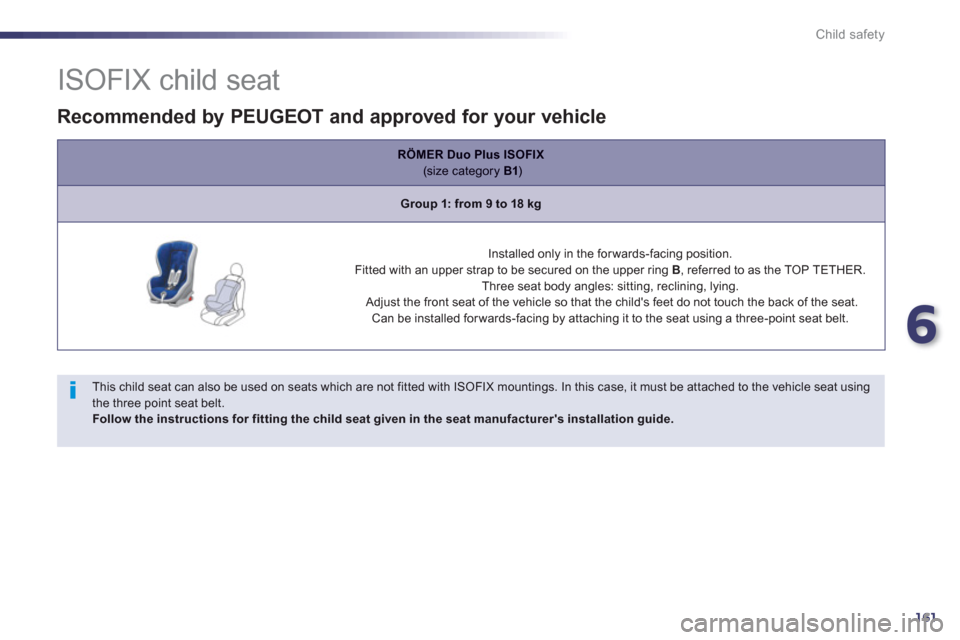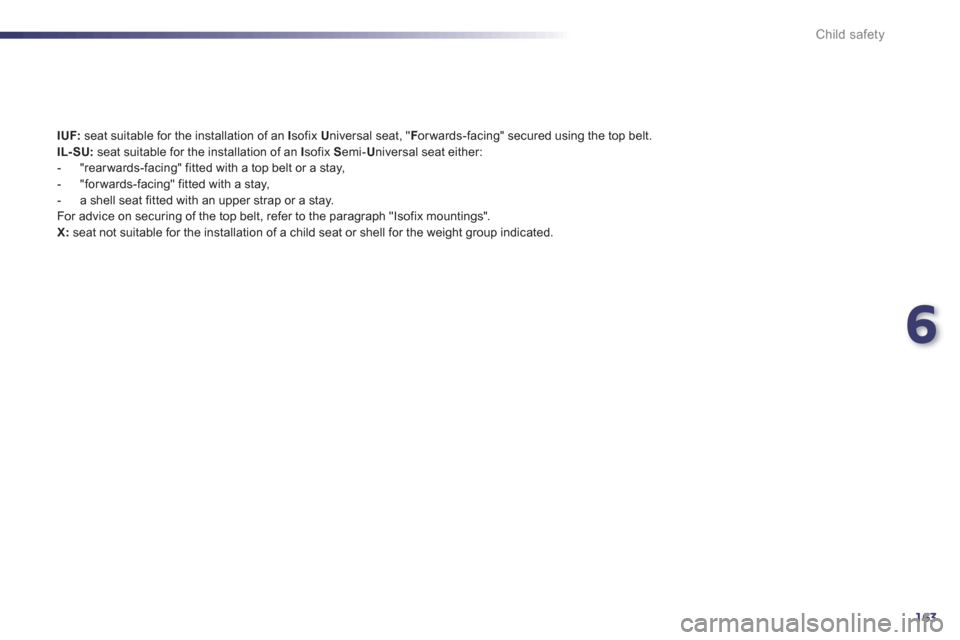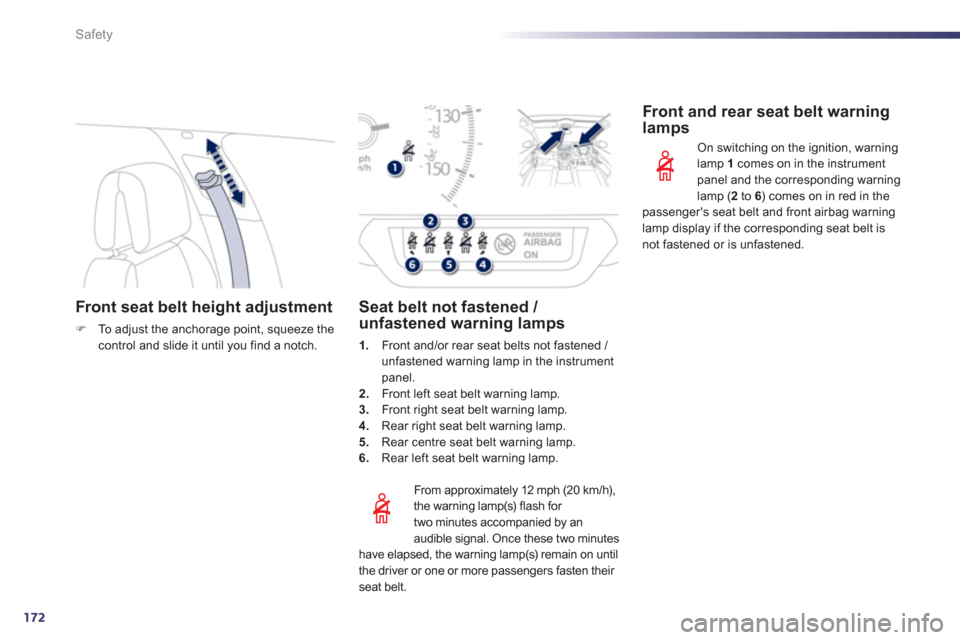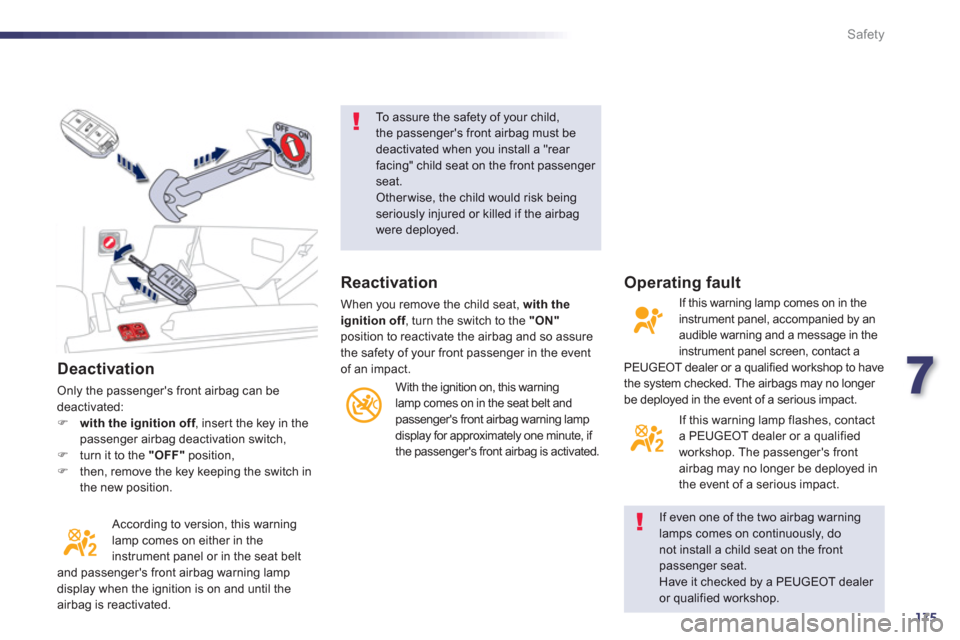2013 Peugeot 508 Hybrid belt
[x] Cancel search: beltPage 161 of 340

6
159
Child safety
The incorrect installation of a child seat in avehicle compromises the child's protection in the event of an accident.
Remember to fasten the seat belts or the child seat harnesses keeping the slack relative to the child's body to a minimum,
even for shor t journeys.
When installing a child seat using the seat belt, ensure that the seat belt is tightenedcorrectly on the child seat and that it secures the child seat firmly on the seat of your vehicle. If your passenger seat is adjustable, move it for wards if necessary.
For optimum installation of the "forwards-facing" child seat, ensure that the back of the child seat is in contact with the back of the vehicle's seat and that the head restraint does not cause any discomfort.
If the head restraint has to be removed, ensure that it is stored or attached securely to prevent it from being thrown around the vehicle in the event of sharp braking.
Advice on child seats
As a safety precaution, do not leave: - a child or children alone and unsupervised in a vehicle, - a child or an animal in a vehicle whichis exposed to the sun, with the windows closed,
- the keys within reach of children inside the vehicle. To prevent accidental opening of the doors and rear windows, use the "Child lock". Take care not to open the rear windows bymore than one third.To protect young children from the rays of the sun, fit side blinds on the rear windows.
Children under the age of 10 must not travel in the "forwards-facing" position on the front passenger seat, unless the rear seats are already occupied by other children, cannot be used or are absent.
Deactivate the passenger airbag when a
"rearwards-facing" child seat is installed on the front seat. Other wise, the child would risk beingseriously injured or killed if the airbag were to inflate.
Installing a booster seat
The chest par t of the seat belt must be positioned on the child's shoulder without touching the neck.
Ensure that the lap part of the seat belt passes correctly over the child's thighs.
PEUGEOT recommends the use of a booster seat which has a back, fitted with a seat belt guide at shoulder level.
Page 163 of 340

6
161
Child safety
ISOFIX child seat
This child seat can also be used on seats which are not fitted with ISOFIX mountings. In this case, it must be attached to the vehicle seat using the three point seat belt.Follow the instructions for fitting the child seat given in the seat manufacturer's installation guide.
Recommended by PEUGEOT and approved for your vehicle
RÖMERDuo Plus ISOFIX(size category B1)
Group 1: from 9 to 18 kg
Installed only in the forwards-facing position.
Fitted with an upper strap to be secured on the upper ring B, referred to as the TOP TETHER.
Three seat body angles: sitting, reclining, lying.
Adjust the front seat of the vehicle so that the child's feet do not touch the back of the seat.
Can be installed for wards-facing by attaching it to the seat using a three-point seat belt
.
Page 165 of 340

6
163
Child safety
IUF:seat suitable for the installation of an Isofix U niversal seat, "F
orwards-facing" secured using the top belt.IL- SU:seat suitable for the installation of an I sofix S emi-U
niversal seat either:
- "rearwards-facing" fitted with a top belt or a stay,
- "forwards-facing" fitted with a stay,
- a shell seat fitted with an upper strap or a stay.
For advice on securing of the top belt, refer to the paragraph "Isofix mountings".
X:seat not suitable for the installation of a child seat or shell for the weight group indicated.
Page 173 of 340

7
171
Safety
Seat belts
Front seat belts Rear seat belts
The rear seats are each fitted with a seat belt,
three-point anchorages with iner tia reel and
force limiter (except for the centre rear seat).
Fastening
F Pull the strap, then inser t the tongue in the buckle.F
Check that the seat belt is fastenedcorrectly by pulling the strap.
Unfastening
F
Press the red button on the buckle.F
Guide the seat belt as it reels in.
Th
e front seat belts are fitted with apretensioning and force limiting system.
This system improves safety in the frontseats in the event of a front or side impact.
Depending on the severity of the impact, thepretensioning system instantly tightens the seat
belts against the body of the occupants.
The pretensioning seat belts are active when
the i
gnition is on.
The force limiter reduces the pressure of the
seat belt on the chest of the occupant, so
improving their protection.
Page 174 of 340

172
Safety
Front seat belt height adjustment
FTo a djust the anchorage point, squeeze thecontrol and slide it until you find a notch.
From approximatel
y 12 mph (20 km/h),
the warning lamp(s) flash for
two minutes accompanied by an
audible si
gnal. Once these two minutes
have elapsed, the warning lamp(s) remain on until
the driver or one or more passengers fasten their seat belt.
Seat belt not fastened / unfastened warning lamps
1.Front and/or rear seat belts not fastened / unfastened warning lamp in the instrument
panel.
2. Front left seat belt warning lamp.3.
Front right seat belt warning lamp.4.Rear right seat belt warning lamp.
5.Rear centre seat belt warning lamp.
6. Rear left seat belt warning lamp.
Front and rear seat belt warning lamps
On switching on the ignition, warninglamp 1
comes on in the instrument
panel and the corresponding warning lamp (2 to 6) comes on in red in thepassenger's seat belt and front airbag warninglamp display if the corresponding seat belt isnot fastened or is unfastened.
Page 175 of 340

7
173
Safety
The driver must ensure that passengers usethe seat belts correctly and that they are allrestrained securely before setting off.
Wherever you are seated in the vehicle, always fasten your seat belt, even for short journeys.
Do not interchange the seat belt buckles asthey will not fulfil their role fully.
The seat belts are fitted with an inertia reel permitting automatic adjustment of the length of the strap to your size. The seat belt isstowed automatically when not in use.
Before and after use, ensure that the seatbelt is reeled in correctly.
The lower par t of the strap must bepositioned as low as possible on the pelvis.
The upper par t must be positioned in the hollow of the shoulder.
The inertia reels are fitted with an automatic locking device which comes into operation inthe event of a collision, emergency braking or if the vehicle rolls over. You can releasethe device by pulling firmly on the strap and releasing it so that it reels in slightly.
Recommendations for children
Use a suitable child seat if the passenger isless than 12 years old or shor ter than one
and a half metres. Never use the same seat belt to secure morethan one person. Never allow a child to travel on your lap.
In order to be effective, a seat belt must:
- be tightened as close to the body as possible,
- be pulled in front of you with a smooth movement, checking that it does nottwist,
- be used to restrain only one person,
- not bear any trace of cuts or fraying,
- not be converted or modified to avoid affecting its per formance.
In accordance with current safety regulations, for all repairs on your vehicle, go to a qualified workshop with the skills and equipment needed, which a PEUGEOT dealer is able to provide.
Have your seat belts checked regularly by a PEUGEOT dealer or a qualified workshop, particularly if the straps show signs of damage.
Clean the seat belt straps with soapywater or a textile cleaning product, sold by PEUGEOT dealers.
After folding or moving a seat or rear bench seat, ensure that the seat belt is positioned and reeled in correctly.
In the event of an impact
Depending on the nature and seriousness of the impact
, thepretensioning device may be deployedbefore and independently of the airbags.Deployment of the pretensioners isaccompanied by a slight discharge of harmless smoke and a noise, due to theactivation of the pyrotechnic cartridgeincorporated in the system.In all cases, the airbag warning lampcomes on.Following an impact, have the seat belts system checked, and if necessary replaced,by a PEUGEOT dealer or a qualified workshop.
Page 176 of 340

174
Safety
Airbags
System designed to maximise the safety of the
occupants (with the exception of the rear centrepassenger) in the event of violent collisions.
It supplements the action of the force-limiting seat belts (with the exception of the rear centrepassenger).
If a collision occurs, the electronic detectors record and analyse the front and side impacts sustained in the impact detection zones:
- in the case of a serious impact, the airbagsare deployed instantly and protect the
occupants of the vehicle (with the exception
of the rear centre passenger); immediately after the impact, the airbags deflate rapidlyso that they do not hinder visibility or the
exit of the occupants,
- in the case of a minor or rear impact or incer tain roll-over conditions, the airbags
will not be deployed; the seat belt alone is
sufficient to provide optimum protection in
th
ese situations.
The airbags do not operate when the ignition is switched off. This equipment will only deploy once. If a second impact occurs (during thesame or a subsequent accident), theairbag will not be deployed again.
Deployment of the airbag(s) is accompanied by a slight emission of harmless smoke and a noise, due to theactivation of the pyrotechnic cartridgeincorporated in the system.This smoke is not harmful, but sensitiveindividuals may experience slight irritation. The noise of the detonation may result in a slight loss of hearing for a shorttime.
Impact detection zones
A.
Front impact zone. B.
Side impact zone.
Front airbags
Deployment
The airbags are deployed simultaneously, unless
the passenger's front airbag is deactivated, in the event of a serious front impact to all or part of thefront impact zone A , in the longitudinal centreline of
the vehicle on a horizontal plane and directed from
the front to the rear of the vehicle.
The front airbag inflates between the thorax and head of the front occupant of the vehicle and thesteering wheel, driver's side, and the dashboard,passenger's side to cushion their forward movement.
System which protects the driver and frontpassenger in the event of a serious front impact
in order to limit the risk of injury to the head and
thorax.
The driver's airbag is fitted in the centre of the steering wheel; the front passenger's airbag isfitted in the dashboard above the glove box.
Page 177 of 340

7
175
Safety
Deactivation
Only the passenger's front airbag can be deactivated:Fwith the ignition off, inser t the key in thefpassenger airbag deactivation switch, F
turn it to the "OFF"position, F
then, remove the key keeping the switch in
the new position.
According to version, this warning lamp comes on either in the instrument panel or in the seat belt
and passenger's front airbag warning lamp
displa
y when the ignition is on and until the
airbag is reactivated.
To assure the safety of your child,the passenger's front airbag must be deactivated when you install a "rear facing" child seat on the front passenger seat.Other wise, the child would risk beingseriously injured or killed if the airbag were deployed.
If even one of the two airbag warning
lamps comes on continuously, donot install a child seat on the frontpassenger seat.
Have it checked by a PEUGEOT dealer or qualified workshop.
Reactivation
When you remove the child seat, with the ignitionoff
, turn the switch to the f"ON"position to reactivate the airbag and so assure
the safety of your front passenger in the event
of an impact.
With the ignition on, this warninglamp comes on in the seat belt and
passenger's front airbag warning lamp
displa
y for approximately one minute, if
the passenger's front airbag is activated.
Operating fault
If this warning lamp comes on in theinstrument panel, accompanied by an audible warning and a message in the
instrument panel screen, contact a
PEUGEOT dealer or a qualified workshop to have
the system checked. The airbags may no longer
be deployed in the event of a serious impact.
If this warnin
g lamp flashes, contacta PEUGEOT dealer or a qualified
workshop. The passenger's front airbag may no longer be deployed in
the event of a serious impact.